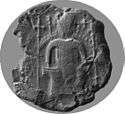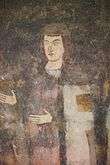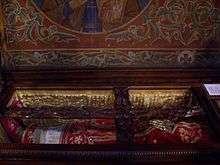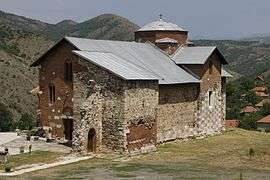Stefan Milutin
| Stefan Milutin | |
|---|---|
| King of all the Serbian and Maritime Lands | |
 King Milutin, (founder's portrait (fresco) in "King's Church" of the Studenica monastery, painted during his lifetime, around 1314) | |
| Reign | 1282–1321 |
| Coronation | 1282 |
| Predecessor | Stephen Dragutin |
| Successor | Stephen of Dečani |
| Born |
Uroš II Milutin Nemanjić 1253 |
| Died | 29 October 1321 (aged 68) |
| Burial | St. Nedelya in Sofia (relocated in 1460) |
| Issue |
Stephen Constantine Stephen Uroš III Dečanski |
| House | Nemanjić dynasty |
| Father | Stefan Uroš I |
| Mother | Helen of Anjou |
| Religion | Serbian Orthodox |
| Signature |
 |
Stefan Uroš II Milutin (Serbian Cyrillic: Стефан Урош II Милутин; c. 1253 – 29 October 1321), known as Stefan Milutin (Стефан Милутин), was the King of Serbia between 1282–1321, a member of the Nemanjić dynasty. He was one of the most powerful rulers of Serbia in the Middle Ages. Miliutin is credited with strongly resisting the efforts of Byzantine Emperor Michael VIII Palaiologos to impose Roman Catholicism on the Balkans after the Union of Lyons in 1274. As most of the Nemanjić monarchs, he was proclaimed a saint by the Serbian Orthodox Church with a feast day on October 30.
Early

He was the youngest son of King Stefan Uroš I and his wife, Helen of Anjou. Unexpectedly he became king of Serbia after the abdication of his brother Stefan Dragutin. He was around 29. Immediately upon his accession to the throne he attacked Byzantine lands in Macedonia. In 1282, he conquered the northern parts of Macedonia including the city of Skoplje, which became his capital. Byzantine Emperor Michael VIII Palaiologos began preparations for war but he died before their completion. The next year Milutin advanced with his brother deep into Byzantine territory all the way to Kavala.
In 1284, Milutin also gained control of northern Albania and the city of Dyrrachion (Durrës). For the next 15 years there were no changes in the war. Peace was concluded in 1299 when Milutin kept the conquered lands as the dowry of Simonis, daughter of Emperor Andronikos II Palaiologos who became his 4th wife. In Nerodimlje župa Milutin had three courts, in Nerodimlje (protected by Petrič), Svrčin and Pauni.[1]
War with the Bulgarian principalities
At the end of the 13th century Bulgarian feudal lords Darman and Kudelin were jointly ruling the region of Braničevo (in modern Serbia) as independent or semi-independent lords. They regularly attacked Stefan Dragutin's Syrmian Kingdom, in Mačva, an area previously under the sovereignty of Elizabeth of Hungary. The Hungarian queen had sent troops to claim Braničevo in 1282–1284, but her forces had been repelled and her vassal lands plundered in retaliation.
.jpg)
Another campaign, this time organized by both Dragutin and Elizabeth, failed to conquer Darman and Kudelin's domains in 1285 and suffered another counter-raid by the brothers. It was not until 1291 when a joint force of Dragutin and the Serbian King Stefan Milutin managed to defeat the brothers and, for the first time ever, the region came under the rule of a Serb, as it was annexed by Dragutin. Responding to Dragutin's annexation of Braničevo the Bulgarian prince named Shishman that came to rule the semi-independent principality of Vidin around 1280, began to attack the Serbian domains to his west.
Shishman was a vassal of Nogai Khan, Khan of the Golden Horde and sought to expand his territories to the west, invading Serbia coming as far as Hvosno, the Bulgarians failed to capture Zdrelo (near Peć) and were pursued back to Vidin by the Serbs. Milutin devastated Vidin and the rest of Shishman's dominion, making Shishman take refuge on the other side of the Danube. The two however became allies after Milutin married Serbian župan Dragoš to the daughter of Shishman, later Milutin would give his daughter Anna to Shishman's son Michael who would become the Tsar of Bulgaria in 1323.

Milutin and Nogai Khan would soon come into conflict because of the war with the Vidin principality. Nogai launched a campaign against Serbia but Milutin offered peace sending his son Stefan Dečanski to Nogai's court. Stefan stayed with his entourage there until 1296 or Nogai Khan's death in 1299.
Feud of the brothers
Disputes began between Milutin and his brother Stefan Dragutin after a peace treaty with the Byzantine Empire was signed in 1299. Dragutin in the meantime held lands from Braničevo in the east to the Bosna river in the west. His capital was Belgrade. War broke out between the brothers and lasted, with sporadic cease-fires, until Dragutin's death in 1314. During this war Milutin appointed Stefan Dečanski as regent in Zeta, modern Montenegro. This meant that Stefan Dečanski was to be heir to the throne in Serbia and not Dragutin's son Stefan Vladislav II.
Battles and supreme leadership
He captured Durres in 1296.[2] On 15 March 1306 Milutin issued a charter to Ratac in which he appointed his son Stephen as his future successor.[3]

The Battle of Gallipoli (1312) was fought by Serbian troops sent by Stefan Milutin to aid Byzantine Emperor Andronikos in the defense of his lands against the Turks. After numerous attempts in subduing the Turks, the rapidly crumbling Byzantine Empire was forced to enlist the help of Serbia. The Turks were looting and pillaging the countryside and the two armies converged at the Gallipoli peninsula where the Turks were decisively defeated. Out of the gratitude to Serbia, the town of Kucovo was donated.
Upon Stefan Dragutin's death in 1314 Milutin conquered most of his lands including Belgrade. But in 1319 Charles I of Hungary regained control over Belgrade and banovina Mačva while Milutin held control in Braničevo. In the year 1314 Milutin's son Stefan Dečanski rebelled against his father, but was captured, blinded and sent to exile in Constantinople. For the rest of Milutin's reign his youngest son Stefan Constantine was considered as heir to the throne, but in the spring of 1321 Stefan Dečanski returned to Serbia and was pardoned by his father.
Family
| Ancestors of Stefan Milutin | |||||||||||||||||||||||||||||||||||||||||||||||||||||||||||||||||||||||||||||||||||||||||||||||||||||||||||||||||||||||||||||||||||||||||||||||||||||||||||||||||||||||||||||||||||||||||||||||||||||||||||||||||||||||||||||||||||||
|---|---|---|---|---|---|---|---|---|---|---|---|---|---|---|---|---|---|---|---|---|---|---|---|---|---|---|---|---|---|---|---|---|---|---|---|---|---|---|---|---|---|---|---|---|---|---|---|---|---|---|---|---|---|---|---|---|---|---|---|---|---|---|---|---|---|---|---|---|---|---|---|---|---|---|---|---|---|---|---|---|---|---|---|---|---|---|---|---|---|---|---|---|---|---|---|---|---|---|---|---|---|---|---|---|---|---|---|---|---|---|---|---|---|---|---|---|---|---|---|---|---|---|---|---|---|---|---|---|---|---|---|---|---|---|---|---|---|---|---|---|---|---|---|---|---|---|---|---|---|---|---|---|---|---|---|---|---|---|---|---|---|---|---|---|---|---|---|---|---|---|---|---|---|---|---|---|---|---|---|---|---|---|---|---|---|---|---|---|---|---|---|---|---|---|---|---|---|---|---|---|---|---|---|---|---|---|---|---|---|---|---|---|---|---|---|---|---|---|---|---|---|---|---|---|---|---|---|---|---|
| |||||||||||||||||||||||||||||||||||||||||||||||||||||||||||||||||||||||||||||||||||||||||||||||||||||||||||||||||||||||||||||||||||||||||||||||||||||||||||||||||||||||||||||||||||||||||||||||||||||||||||||||||||||||||||||||||||||
By his first wife, Jelena (a minor Serbian noblewoman), he had two children:
- King Stephen Uroš III
- Anna Neda, who married Michael Shishman of Bulgaria
By his second wife, Helena, daughter of sebastokratōr John I Doukas of Byzantine ruler of Thessaly and Hypomone, he had no children.
By his third wife, Elizabeth, daughter of King Stephen V of Hungary and Elizabeth the Cuman, Milutin had:
- Zorica, known as Tsaritsa (Empress)
By his fourth wife, Anna, the daughter of George I of Bulgaria, Stefan Uroš II Milutin had the following children:
- Stefan Konstantin, anti-King
By his fifth wife Simonis, the daughter of Emperor Andronikos II Palaiologos, he had no children.

Aftermath and legacy
At the end of Milutin's life Serbia was second in strength in Southeast Europe after Hungary. During his reign many court ceremonials were taken over from the Byzantine court and Byzantine culture overflowed into Serbia. Milutin was also well known as the founder of many monasteries: Gračanica monastery, Our Lady of Ljeviš, the church of Vavedenje in Hilandar and many more. After his death a short civil war followed, after which the Serbian throne was ascended by his eldest son, Stefan Dečanski.
He is included in The 100 most prominent Serbs.
Endowments of Stefan Milutin
| Image | Name | Location | Date |
|---|---|---|---|
| |
Bukovo monastery | Negotin, Serbia | 13-14th century |
 |
Church of St. Nicetas | Banjane, Macedonia | ca. 1300 |
 |
Our Lady of Ljeviš | Prizren, Kosovo[lower-alpha 1] | 1306–1307 |
| |
"King's Church" of the Studenica monastery | Kraljevo, Serbia | 1313–1314 |
 |
Church of St. George | Kumanovo, Macedonia | 1313–1318 |
 |
Banjska monastery | near Zvečan, Kosovo[lower-alpha 1] | 1318 |
 |
"Church of Entrance of the Theotokos" of the Hilandar monastery | Mount Athos, Greece | 1320 |
 |
Gračanica monastery | Gračanica, Kosovo[lower-alpha 1] | 1321 |
| |
Koroglaš monastery | near Negotin, Serbia | 14th century |
 |
Vratna monastery | near Negotin, Serbia | 14th century |
References
- ↑ Popović, Bogdan; Skerlić, Jovan (1932). Srpski književni glasnik. p. 388. Retrieved 20 December 2013.
... Милутннови Неро- димл.а, Петрч и Пауни...
- ↑ "[Projekat Rastko - Skadar] Stanovnistvo slovenskog porijekla u Albaniji". Retrieved 12 September 2014.
- ↑ Zbornik radova Vizantoloshkog instituta. Institut. 2009. p. 338.
- 1 2 3 Kosovo is the subject of a territorial dispute between the Republic of Kosovo and the Republic of Serbia. The Republic of Kosovo unilaterally declared independence on 17 February 2008, but Serbia continues to claim it as part of its own sovereign territory. The two governments began to normalise relations in 2013, as part of the Brussels Agreement. Kosovo has received recognition as an independent state from 110 out of 193 United Nations member states.
Sources
- Fajfrić, Željko (2000) [1998], Sveta loza Stefana Nemanje, Belgrade: Tehnologije, izdavastvo, agencija Janus
- Fine, John Van Antwerp (1994), The Late Medieval Balkans: A Critical Survey from the Late Twelfth Century to the Ottoman Conquest, University of Michigan Press, ISBN 978-0-472-08260-5
Further reading
- Mošin, V. (1971) Povelje kralja Milutina - diplomatička analiza. Istorijski časopis, XVIII
- Ćirković, S.M. (1991) Biografija kralja Milutina u Ulijarskoj povelji. in: Đurić V.J. [ed.] Arhiepiskop Danilo II i njegovo doba, Međunarodni naučni skup povodom 650 godina od smrti, decembar 1987, Beograd: Srpska akademija nauka i umetnosti / SANU - Odeljenje istorijskih nauka
| Wikimedia Commons has media related to Stefan Uroš II Milutin of Serbia. |
| Stefan Milutin Born: 1253 Died: 29 October 1321 | ||
| Regnal titles | ||
|---|---|---|
| Preceded by Stefan Dragutin |
King of Serbia 1282–1321 |
Succeeded by Stefan Uroš III Dečanski |